Bud Break 2014 Underway
by Ed Kelly
on May 16, 2014
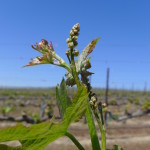 Bud break began much the same time as 2013, but we have had cooler weather than in 2013 so progress was a little slower this year, and the same was true for shoot growth. This week, however, the temperature climbed into the 80’s and shoot growth has begun to take off. Photos from May 15 are available here.
Bud break began much the same time as 2013, but we have had cooler weather than in 2013 so progress was a little slower this year, and the same was true for shoot growth. This week, however, the temperature climbed into the 80’s and shoot growth has begun to take off. Photos from May 15 are available here.
Last week we added minerals into the irrigation water to assist with early season shoot growth and the minerals are now starting to take effect. We increased our crew size and began to sucker the cordon and select primary shoots for fruit. We have completed suckering and shoot selection on about one-quarter of the vineyard so progress is good.
Also, we have now completed the trellis installation in the new Chardonnay block 23 planting. The installation of the trellis was a little more difficult than expected due to rock in the upper section of the block. We had to rent a compressor and two 60-pound jackhammers to break the rock in order to install the line posts and the end posts. All that remains to be done now, aside from planting, is to install the emitters in the drip line. We are soaking the cuttings that I recently pulled from cold storage and will soon be callusing them, followed by planting. This process should take about three more weeks.
An update on bud break by block is available here.
Spring Bud Swell and Vineyard Development
by Ed Kelly
on April 17, 2014
 Stillwater Creek Vineyard is now in the beginnings of bud break. We do not yet have official leaves, but we do have bleeding from the pruning cuts and bud swell. Bud swell is also called the” Wooly Bud” stage.
Stillwater Creek Vineyard is now in the beginnings of bud break. We do not yet have official leaves, but we do have bleeding from the pruning cuts and bud swell. Bud swell is also called the” Wooly Bud” stage.
2014 bud break may be a little ahead of 2013, but it is too early to make that call. If the weather stays cool we could see our first leaves within the week, which would put us at last year’s bud break date of April 24, 2013. Even though the process of bud break begins with bleeding I do not call bud break until I see the first leaves.
We are now making a final pass through the vineyard to tie down replacement canes and make a final post-pruning cleaning pass. We are also chopping canes, mowing and making final repairs to the trellis system.
We have also begun the development of Block 23 Chardonnay but are now on hold waiting for trellis and irrigation supplies to arrive, which should this week. A few pictures of block 23 developments can be found here. Cuttings for both the block 23 planting and block 18B, where we plan to graft a new clone of Syrah, are budding in cold storage. Our neighbor, Josh Lawrence, has given us space in his cold storage facility in Royal City. I hope to remove the cuttings for Block 23 from cold storage next week and begin the process of callusing the cuttings. The callusing process should take two weeks to a month, at which point the cuttings will be planted at vine stakes and nurseries in the block. The cutting for Block 18B grafting will stay in cold storage until the end of May, when we will likely begin grafting.
The development of block 23 is going smoothly except for the upper 30 yards of the block that is very rocky and the installation of line posts and end posts is slow. I will be renting and compressor and a couple of jack hammers to assist in breaking through the rock to get the line posts installed.
View photos
2013 Growing Season Comes to a Close
by swc
on December 1, 2013
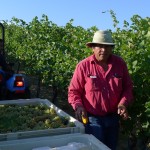 Mother Nature delivered her share of challenges in 2013, as she always does; but overall 2013 was a more manageable season than the previous two vintages and the resulting harvest was very successful.
Mother Nature delivered her share of challenges in 2013, as she always does; but overall 2013 was a more manageable season than the previous two vintages and the resulting harvest was very successful.
Bud break came early, and a warm, dry weather pattern developed into late June and continued through July. August temperatures cooled slightly but remained warm, however, the evening temperature drops in August were much less than is typical of the Columbia Valley. By all indications, it appeared harvest would arrive early and progress rapidly, but in mid-September, the weather cooled dramatically, slowing maturation considerably. Throughout the rest of the fall ripening advanced slowly, and the final bin of grapes made its way to the last winery on Nov. 1.
Particularly noteworthy was the small berry size of our Cabernet Sauvignon and Merlot in 2013. This is a goal we have worked diligently to achieve over the past two years, and it was satisfying to please winemakers by delivering grapes with great color, flavor and complexity that should produce some exciting wine in the coming years. As always, the vineyard delivered many photo ops. Here are a few of our favorite images from the 2013 growing season.
Harvest is Here!
by swc
on September 11, 2013
 We picked our first grapes of the season on Sept. 11th, gorgeous Chardonnay and Sauvignon Blanc destined for Matthews Cellars from blocks 25 and 24A respectively. Check back often for photos and enjoy the first of the season.
We picked our first grapes of the season on Sept. 11th, gorgeous Chardonnay and Sauvignon Blanc destined for Matthews Cellars from blocks 25 and 24A respectively. Check back often for photos and enjoy the first of the season.
Fine Tuning for Quality
by Ed Kelly
on August 30, 2013
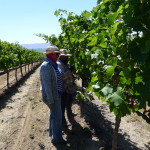
With most of the blocks through veraison, we are now moving through the vineyard in order of varietal ripening, dropping fruit with the goal of getting close to targeted yields. We will leave just a little extra fruit now to allow for a final pass at which time we will remove any lower quality fruit and make final yield adjustments. This is one of the most difficult and subjective parts of vineyard operations during the course of the season.
Yield is equal to the number of clusters per vine x the average cluster weights. The clusters will increase in weight from lag phase to harvest by 2X. We are weighing and counting clusters prior to moving into each block to establish a current average cluster weight, per block and will then estimate final harvest cluster weight as a percentage cluster weight increase from this point in time. With this information in hand, we will then reduce the number of clusters per vine to determined numbers. Fruit is removed in this order: short shoot fruit; bunched fruit; grapes that are significantly behind in veraison; and fruit that needs to be dropped to allow the proper number of clusters for targeted yields. For a look at the vineyard this month, click here.
Veraison Underway; Grapes Ripening Quickly
by Ed Kelly
on August 23, 2013
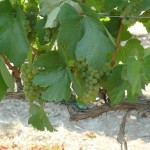 Veraison is underway and appears to be a little earlier than last year. The grapes are ripening rapidly.
Veraison is underway and appears to be a little earlier than last year. The grapes are ripening rapidly.
We are now adjusting crop loads and have completed the first pass on all the white grapes and are through most of the Merlot. We leave more grapes on the vines than we want at harvest on this first pass and will return to make a final adjustment before picking. During this first pass, we drop clusters from short shoots, balled fruit, fruit that is very green and begin adjusting to near target yields. We will return later and make a final adjustment to the crop load, leaving the best fruit to harvest.
If you are interested in veraison data, follow this link to check the date each block reaches 100%.
Harvest Approaching Quickly
by Ed Kelly
on August 14, 2013
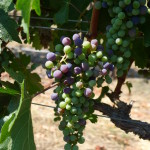 With relatively few exceptions, the 2013 Columbia Valley growing season has been quite warm thus far, and we are moving through veraison earlier than we have in the last several years. One of those “exceptions” occurred last weekend when we dodged a bullet as a storm moved through the area that threw some nasty hail, but it missed Stillwater Creek by a few miles and warm, stable conditions have now returned.
With relatively few exceptions, the 2013 Columbia Valley growing season has been quite warm thus far, and we are moving through veraison earlier than we have in the last several years. One of those “exceptions” occurred last weekend when we dodged a bullet as a storm moved through the area that threw some nasty hail, but it missed Stillwater Creek by a few miles and warm, stable conditions have now returned.
If the warm weather continues, harvest will begin earlier than is typical. The season’s high temperatures combined with small clusters, lower than average berry set (the number of berries that set following bloom) and small berry size all point towards early ripening and high sugars.
With this in mind, our goal now is to slow things down just a bit to extend the “hang time” to achieve ideal sugar levels at grape maturity. There are several things we do in the vineyard to extend the ripening process, including adjusting cluster counts later than normal and hedging the canopy a bit later and shorter than is typical. The conditions make it more challenging to hit target yields, since we will make most of the final crop levels adjustments when the vines are near full veraison at which time we will drop fruit that is not going through veraison well. In a more typical year when target yields are easier to estimate, we would send the crews out to crop thin before veraison. The silver lining here is that by crop thinning a little later in the season, we also slow down the ripening process a bit.
Managing for Success
by Ed Kelly
on July 1, 2013
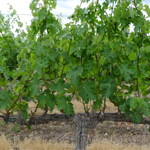 It is hot this morning but not as hot as expected — yet. Today could be 107-degrees plus. Because we are coming out of a two week period of cool weather and the extreme hot weather appeared so suddenly, we have decided to delay pulling leaves from the vine in order to give the fruit a little more shade protection. When the temperatures cool near the end of the week, we will resume the leafing process.
It is hot this morning but not as hot as expected — yet. Today could be 107-degrees plus. Because we are coming out of a two week period of cool weather and the extreme hot weather appeared so suddenly, we have decided to delay pulling leaves from the vine in order to give the fruit a little more shade protection. When the temperatures cool near the end of the week, we will resume the leafing process.
Prior to this heat wave, however, we spent two weeks positioning the shoots, removing leaves and lateral shoots, and trunk suckering. We shoot position by moving shoots vertically up through the trellis wires on the east side (morning side) of the vines to allow for sunlight penetration and airflow. On the west side of the vines, we move about 60 percent of the shoots up through the trellis wires. The remaining shoots will be left to sprawl and provide a little more shade on the warmer, afternoon side of the plant.
We have also been working on removing lateral shoot growth. On the morning side of the vines, we remove lateral shoot growth up to but not including the upper cluster, along with the lowest two leaves. Again, our goal is to leave one layer of leaves over the fruit to keep the fruit from burning, while at the same time allowing adequate sunlight into the canopy for proper fruit coloring. On the west side of the vines, we remove lateral shoot growth up to but not including the upper cluster. Once more, our goal here on the west side of the plant, which gets more intense sunlight and heat exposure for longer hours than the east side, is to provide adequate sunlight exposure with a little extra protection. The interior leaves in the fruit zone that are not exposed directly to the sun will also be removed in order to increase air flow and improve sunlight penetration through the canopy.
In addition, we are completing our second pass through the vineyard to remove unwanted shoot growth from the trunk of the vine. Here are a few photos taken at the vineyard recently showing our progress.
Bloom Complete; Set Looks Excellent
by Ed Kelly
on June 21, 2013
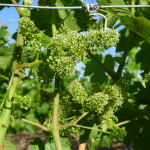 As of Monday, June 17th, all blocks had finished bloom, and we are now beginning to see berry set. So far, set looks excellent and we are working on shoot positioning now, a process that involves moving the shoots on the east side of the vine vertically up through the wires. At the same time, we are removing lateral growth up to the top cluster on the east side (or morning side) of the vine. We will make a second pass later to manage shoot growth on the west side of the vine. On the west side, a few shoots will be left to sprawl slightly to provide a little sun protection from the long desert afternoon. In all cases, our goal is to leave one layer of leaves to provide a mixture of shade and sun on the fruit. By providing slightly more sun exposure on the cooler morning side of the vine, we balance out color and fruit development on both sides of the plant.
As of Monday, June 17th, all blocks had finished bloom, and we are now beginning to see berry set. So far, set looks excellent and we are working on shoot positioning now, a process that involves moving the shoots on the east side of the vine vertically up through the wires. At the same time, we are removing lateral growth up to the top cluster on the east side (or morning side) of the vine. We will make a second pass later to manage shoot growth on the west side of the vine. On the west side, a few shoots will be left to sprawl slightly to provide a little sun protection from the long desert afternoon. In all cases, our goal is to leave one layer of leaves to provide a mixture of shade and sun on the fruit. By providing slightly more sun exposure on the cooler morning side of the vine, we balance out color and fruit development on both sides of the plant.
For a complete list of bloom dates by block, download the Vintage Update chart found here.
Bloom in Progress Under Sunny Skies
by Ed Kelly
on June 5, 2013
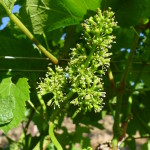 The story of the growing season thus far has been one of fits and starts. Bloom is underway and depending on the rate of progress, we could be a week ahead of last year. We shall see, however.
The story of the growing season thus far has been one of fits and starts. Bloom is underway and depending on the rate of progress, we could be a week ahead of last year. We shall see, however.
Spring started off very warm and early shoot growth was strong and rapid, but the last two weeks of May were cool and rainy and as a result, shoot growth came to a near halt. This week’s weather has been warm and the trend is expected to continue, good news for Stillwater Creek since we are now in bloom.
Work in the vineyard to set us up for a success vintage continues. We are now a few blocks away from completing our first pass at trunk suckering and shoot selection. Shoot growth is strong with most shoot up to the upper wire. The goal of the first pass of shoot selection on the cordons is to get rid of unwanted shoot growth along the cordon. Our goal is to have about four shoots per foot evenly spaced along the cordon, eliminating unwanted shoot growth from latent buds. The shoots are selected from buds we have left during the pruning process last winter. Shoots of this density provide plentiful cluster counts and are spaced for excellent sunlight penetration into the canopy during the growing season. With proper shoot spacing, along with some leaf and lateral removal, fruit clusters receive ideal light to grow top quality grapes. Shoot selection also paves the way for the best pruning selection for the next year.
View more photos from today.
 Bud break began much the same time as 2013, but we have had cooler weather than in 2013 so progress was a little slower this year, and the same was true for shoot growth. This week, however, the temperature climbed into the 80’s and shoot growth has begun to take off. Photos from May 15 are available here.
Bud break began much the same time as 2013, but we have had cooler weather than in 2013 so progress was a little slower this year, and the same was true for shoot growth. This week, however, the temperature climbed into the 80’s and shoot growth has begun to take off. Photos from May 15 are available here.








